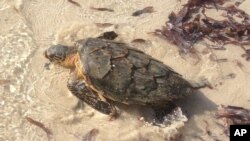A turtle drags itself along a white sandy beach, splashes through the gentle warm Indian Ocean and then vanishes with a plop, becoming one of 13,750 turtle success stories on a stretch of Kenyan coastline facing pressure from developers.
Kenya is striving to strike a balance between developing its 330 miles (530 kilometers) of coastline for a billion-dollar tourism industry that employs a half-million people and preserving the environment that attracts those visitors. As the East African nation does so, some experts say that turtles are key, because they are so picky when it comes to laying eggs that if the right environment is maintained for them, then things are going well.
Kenya's record is mixed in protecting endangered turtles, but is going pretty well, a top wildlife official says.
One of several sore spots for conservationists and locals — and not least of all, the turtles — is a hotel of former Renault F1 tycoon Flavio Briatore, 25 kilometers (16 miles) north of here.
The dispute centers around Briatore's Billionaire Resort on Malindi beach and its 100-meter concrete seawall to protect the property and guests from the elements.
Malindi resident David Kirk said the resort has been an "absolute environmental disaster,'' in which forests full of nesting birds were destroyed and soil erosion because of the seawall had stopped turtles from coming ashore to lay eggs.
Resort general manager Stephanie Ravessoud said the seawall was built following all government requirements and respects the environment.
"Erosion has been there for decades. Everybody knows that sand in our area is being washed away long before the building of our wall,'' she said.
Marine biologist Casper Van de Geer said turtles need quiet, sandy beaches to lay eggs and large tourist resorts or housing developments disturb that process.
"Light and noise scare them off,'' he said. "They lay their eggs above the high water mark. The nest has to be warm and above the water, so erosion affects that.''
Local Ocean Trust runs a rehabilitation center in Watamu that Van de Geer manages where sick or injured turtles are nursed back to health. The group also compensates local fishermen for turtles caught in their nets or found sick or injured.
"A big adult turtle can fetch up to $500 on the black market,'' Van de Geer said. "Fisherman earn about $100 a month, in a good month. So one turtle is almost half a year of work
"Turtle conservation is crucial because it also protects the habitat for thousands of other species, including sharks, dolphins and whales,'' Van de Geer said. "By protecting turtles you are protecting beaches, mangroves, open ocean, reefs and sea grass, which is virtually every ecosystem in the tropical ocean.''
Dr. Richard Leakey, chairman of the governmental Kenya Wildlife Service, said that while tourism and humans have invariably affected the environment, locally run projects on Kenya's coast have sustained endangered turtle population over the past decade.
"The situation these days is much better,'' Leakey said. "We still have problems with turtles getting stuck in trawler nets but we've seen very positive signs regarding turtle numbers.''
The Local Ocean Trust has rescued and sent back to the ocean turtles 13,750 times over the past 20 years of working in Watamu, according to Van de Geer. A turtle tagged in Watamu was later found in the Chagos archipelago 2,300 miles(3,700 kilometers) away, he said.
"From Mozambique, to Australia, to India and Thailand, we all have a stake in this,'' he said. "The beach here has an impact on the entire ocean, that's the weird and amazing thing about turtles.''
Of species found in Kenya, the Hawksbill turtle is critically endangered and the Green turtle is endangered while the Leatherback, Olive Ridley and Loggerhead turtles are vulnerable to becoming extinct, according to the International Union for Conservation of Nature.
"Despite our efforts, man remains the turtle's most serious enemy,'' Van de Geer said.
Turtles Key as Kenya Balances Ecology, Development

WATAMU, KENYA —






